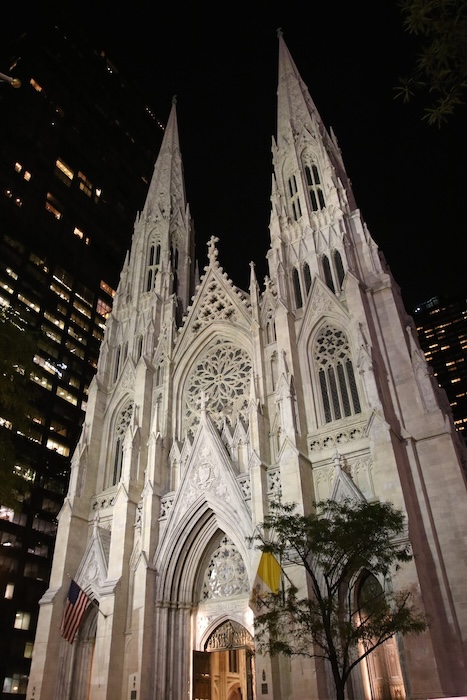— The San Diego diocese’s Chapter 11 petition will be filed Monday, Cardinal Robert McElroy says

The Roman Catholic Diocese of San Diego announced Thursday that it plans to return to U.S. bankruptcy court to help manage its response to hundreds of lawsuits filed by people who say they were sexually assaulted by Catholic priests when they were young.
It is the second time San Diego church officials have gone to bankruptcy court to limit damage from claims from child sex-abuse victims.
Cardinal Robert McElroy, who serves as bishop to the 1.4 million Catholics in San Diego and Imperial counties, alerted parishioners to the decision in an open letter that was publicly released by the diocese on Thursday.
The legal action, which is expected to be filed Monday, comes after church officials acknowledged last year that they were considering a return to bankruptcy court and began mediation with survivors.
“For the past year, the Diocese has held substantive and helpful negotiations with the attorneys representing the victims of abuse, and I, in collaboration with the leadership of the Diocese, have come to the conclusion that this is the moment to enter formally into bankruptcy and continue negotiations as part of the bankruptcy process,” McElroy wrote.
Lawyers representing the 400-plus plaintiffs in San Diego Superior Court lawsuits said the decision shows the diocese is more interested in protecting its assets than protecting the people who attended its schools and services.
“After nearly a year of mediation, we were hoping that child sexual abuse survivors, the Diocese and its insurer would have been able to reach a settlement and an agreed-to plan for compensating victims through the inevitable bankruptcy announced by the Diocese about a year ago,” plaintiffs’ attorney Irwin Zalkin said.
“Unfortunately, that hasn’t happened.”
Plaintiffs’ lawyers said the Catholic Diocese of San Diego is the 13th diocese across the country to seek bankruptcy protection from sexual-abuse survivors.
“It has become very clear that these Catholic Diocese and their insurers have adopted a national strategy to use Chapter 11 bankruptcies to resolve child sexual abuse cases in a way that reduces the compensation paid to survivors,” said attorney Devin Storey, a Zalkin law partner who also represents victims.
McElroy said the Diocese was facing two moral claims: the need for just compensation for victims and the need to further the church’s mission of education, service and outreach to the poor and neglected.
“Bankruptcy offers the best pathway to achieve both,” he said.
In 2007, the Diocese of San Diego agreed to pay almost $200 million to 144 people who reported sexual abuse by priests — a settlement that was reached after the church filed for bankruptcy protection.
The Chapter 11 proceeding more than 15 years ago was marred by accusations from victims’ lawyers that church officials deliberately hid assets from the bankruptcy court in order to limit damages.
Zalkin on Thursday circulated quotes from the judge who oversaw the 2007 case.
“The term ‘disingenuous’ as applied to the Diocese description of assets available to fund the settlement is completely accurate,” then-U.S. Bankruptcy Court Judge Louise De Carl Adler said in a ruling.
“The church needs to look within itself,” she added. “Chapter 11 is not supposed to be a vehicle or a method to hammer down on the claims of the abused.”
A state law passed in 2019 opened a new window for victims of clergy sex abuse to file claims against the church for three years ending in 2022 — and ultimately resulted in 457 new claims against the San Diego diocese.
That same year, in the weeks leading up to the bill being signed into law, the diocese systematically transferred ownership of hundreds of its properties.
According to an analysis by The San Diego Union-Tribune published last year, the diocese owned 376 properties at the start of 2019 but just 76 by that year’s end — an 80 percent drop. None of the property transfers involved money changing hands or other monetary consideration.
Church officials said the changes were not aimed at reducing assets in response to the 2019 legislation. Rather, a spokesperson told the Union-Tribune that process of transferring church assets had begun in 2010 and simply took years to complete.
The bankruptcy filing expected to be filed Monday will involve only the diocese itself, church officials said — not the 96 individual parishes, 49 elementary and secondary schools or the charitable or other programs that operate under the church’s guidance.
Even so, schools and parishes may have to help pay off any eventual settlement, McElroy said.
“It is clear that as part of providing appropriate compensation to past victims of the sexual abuse of minors, both the parishes and high schools will have to contribute substantially to the ultimate settlement in order to bring finality to the liability they face,” he wrote.
In his message to parishioners, McElroy said almost 60 percent of the allegations brought forward in the current litigation are more than 50 years old. He also said the church has taken steps to prevent such abuse but that those reforms do not excuse past behavior.
“The tremendous strides we have made in the past 20 years to protect minors in the church and beyond cannot begin to mitigate the enormous moral responsibility that I, as your bishop, and the entire Catholic community continue to bear,” he wrote.
“May God never let this shame pass from our sight, and may God’s tenderness envelop the innocent children and teenagers who were victimized.”
Complete Article ↪HERE↩!




:format(jpg)/cloudfront-us-east-1.images.arcpublishing.com/baltimorebanner/JMXMRNT755CMJFV72GIZFXWRIE.jpg)
:format(jpg)/cloudfront-us-east-1.images.arcpublishing.com/baltimorebanner/ZITT6NQFBJCZXEZS5HFCVVV2H4.jpg)
